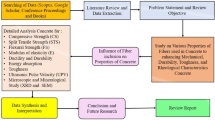Abstract
Carbon fibers and corresponding composites are being widely used in strengthening and repairing existing reinforced concrete structures. The piezoresistive effect of carbon fibers can be applied to self-monitor its stress and damage. However, rare piezoresistive models can be found in the literature considering the mesoscopic mechanism and material randomness of carbon fiber bundles to quantify the piezoresistive effect. The piezoresistive effect of carbon fiber bundles is mainly affected by the elastic deformation, breakage, and contact of filaments. In this paper, according to the analysis of these factors, a dynamic random equivalent parallel circuit model was established to quantify the piezoresistive effect of carbon fiber bundles during tension. With tensile results of 54 carbon fiber bundles, the uncertainties of filaments, such as the initial breakage, tensile breakage and contact change, were analyzed and their probability distributions were determined. The strength of filaments is subject to the Weibull distribution. Kolmogorov–Smirnov (K–S) test results show that the initial breakage ratio obeys a truncated lognormal distribution and the relative contact ratio change obeys a truncated normal distribution. Then Monte Carlo simulations were used to calculate the electrical resistance of carbon fiber bundles during tension. Comparing the simulated resistance with that of 15 verifying specimens, this piezoresistive model and calculation method is reliable and valid.














Similar content being viewed by others
Data availability
Data will be made available upon reasonable request.
References
Zheng L, Li Z, Song X, Lv Y. Effect of strain on the electrical resistance of continuous carbon fiber monofilament. J Funct Mater. 2008;39(3):440–2 (in Chinese).
Liu R, Xu Z, Yin J, Huang J, Liu D, Xie G. A coupled mechanical and electrical model concerning piezoresistive effect of CFRP materials. Compos B Eng. 2016;96:125–35. https://doi.org/10.1016/j.compositesb.2016.04.010.
Arboleda D. Fabric reinforced cementitious matrix (FRCM) composites for infrastructure strengthening and rehabilitation: characterization methods. Dissertation, University of Miami; 2014.
Goldfeld Y, Perry G. Electrical characterization of smart sensory system using carbon based textile reinforced concrete for leakage detection. Mater Struct. 2018;51(6):1–17. https://doi.org/10.1617/s11527-018-1296-7.
Kang BG, Hannawald J, Brameshuber W. Electrical resistance measurement for damage analysis of carbon yarns. Mater Struct. 2011;44(6):1113–22. https://doi.org/10.1617/s11527-010-9687-4.
Sevkat E, Li J, Liaw B, Delale F. A statistical model of electrical resistance of carbon fiber reinforced composites under tensile loading. Compos Sci Technol. 2008;68(10–11):2214–9. https://doi.org/10.1016/j.compscitech.2008.04.011.
Lv Y. Functional properties and application of smart polymer-matrix carbon fiber bundle. Dissertation, Wuhan University of Technology; 2011.
Zhou W, Li H, Ou J. Self-monitoring performance of the carbon fiber sheet without epoxy resin matrix. Acta Mater Compos Sin. 2005;22(2):63–6 (in Chinese).
Owston CN, Conor PC. Electrical resistance of single carbon fibres. Nature. 1969;223(5211):1146–7. https://doi.org/10.1038/2231146b0.
Li H, Zhou W, Ou J. Study on electromechanical behavior of unidirectional carbon fibre sheet without epoxy resin matrix. Adv Struct Eng. 2004;7(5):437–45. https://doi.org/10.1260/13694330428632.
Xu Z. Research on carbon fiber composite self-sensing performance of prestressed concrete structure. Dissertation, Jiangsu University; 2016.
Huang J. Structure state monitor system based on stress-resistance effect of carbon fiber reinforced plastic (CFRP). Dissertation, Jiangsu University; 2017.
Liu R, Ping S, Yin J, Huang J, Liu D, Xie G. Analysis of parameters and influence factors on a piezoresistance model of CFRP materials. Constr Build Mater. 2017;157:546–53. https://doi.org/10.1016/j.conbuildmat.2017.09.066.
Zachariev G. A statistical theory of the damage of materials. Mod Mech Eng. 2016;6(4):129–50. https://doi.org/10.4236/mme.2016.64013.
Zok FW. On weakest link theory and Weibull statistics. J Am Ceram Soc. 2017;100(4):1265–8. https://doi.org/10.1111/jace.14665.
Schulte K, Baron C. Load and failure analyses of CFRP laminates by means of electrical resistivity measurements. Compos Sci Technol. 1989;36(1):63–76. https://doi.org/10.1016/0266-3538(89)90016-X.
Fang X, Ge Q, Zhu S, Li Z. Research on response mechanism of contact resistance under tension. J Funct Mater. 2012;43(20):2815–7.
Zhang Q. Quantum mechanics. 1st ed. Beijing: Science Press; 2002.
Du S, Wang B. Micromechanics of composite materials. 1st ed. Beijing: Science Press; 1998.
He F, Wang R. Weibull analysis of carbon fiber strength. Carbon. 1987;30(2):12–5 (in Chinese).
Coleman BD. On the strength of classical fibres and fibre bundles. J Mech Phys Solids. 1958;7(1):60–70. https://doi.org/10.1016/0022-5096(58)90039-5.
Wang S, Wang D, Chung DDL, Chung J. Method of sensing impact damage in carbon fiber polymer–matrix composite by electrical resistance measurement. J Mater Sci. 2006;41(8):2281–9. https://doi.org/10.1007/s10853-006-7172-9.
Shen L, Li J, Liaw BM, Delale F, Chung J. Modeling and analysis of the electrical resistance measurement of carbon fiber polymer–matrix composites. Compos Sci Technol. 2007;67(11–12):2513–20. https://doi.org/10.1016/j.compscitech.2006.12.020.
Salem B, Mohammed S, Fazal AA. Experimental and numerical investigations on the mechanical characteristics of carbon fiber sensors. Sensors. 2017;17(09):2026. https://doi.org/10.3390/s17092026.
Ang AHS, Tang WH. Probability concepts in engineering: emphasis on applications to civil and environmental engineering. 2nd ed. Hoboken: Wiley; 2007.
Chen G. Mechanism research on piezoresistive effect of dry carbon fiber bundle and that in CFRCM. Dissertation, Zhejiang University; 2021.
Acknowledgements
This work was supported by Guangdong Provincial Key Areas R&D Programs, Special Project for Research and Development in Key areas of Guangdong Province (2019B111107002) and the National Natural Science Foundation of China (51878604, 52078454, 51820105012).
Author information
Authors and Affiliations
Corresponding author
Ethics declarations
Conflict of interest
On behalf of all authors, the corresponding author states that there is no conflict of interest.
Ethical approval
This article does not contain any studies with human participants or animals performed by any of the authors. This study was done according to ethical standards.
Additional information
Publisher's Note
Springer Nature remains neutral with regard to jurisdictional claims in published maps and institutional affiliations.
Rights and permissions
Springer Nature or its licensor (e.g. a society or other partner) holds exclusive rights to this article under a publishing agreement with the author(s) or other rightsholder(s); author self-archiving of the accepted manuscript version of this article is solely governed by the terms of such publishing agreement and applicable law.
About this article
Cite this article
Gong, Y., Xie, Z., Liu, J. et al. Research on piezoresistive effect and random model of carbon fiber bundle. Archiv.Civ.Mech.Eng 23, 128 (2023). https://doi.org/10.1007/s43452-023-00672-0
Received:
Revised:
Accepted:
Published:
DOI: https://doi.org/10.1007/s43452-023-00672-0




